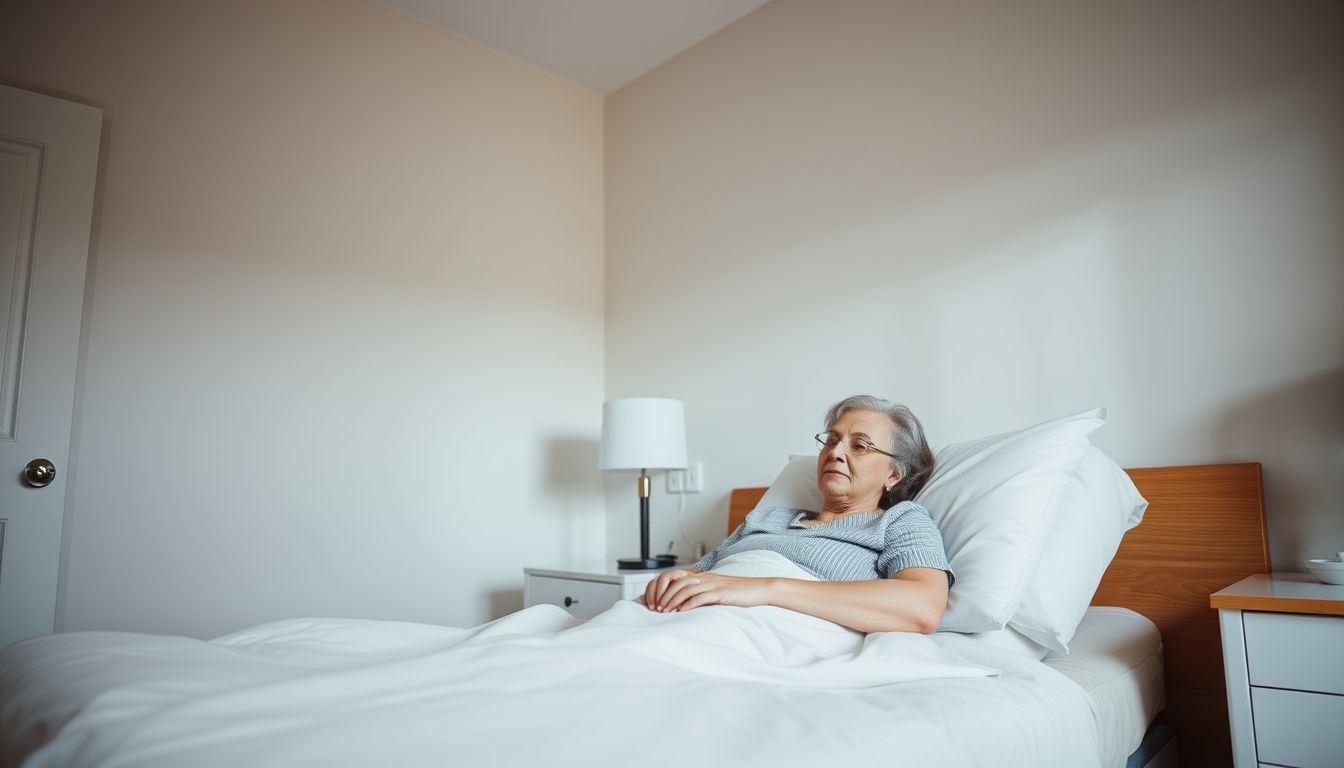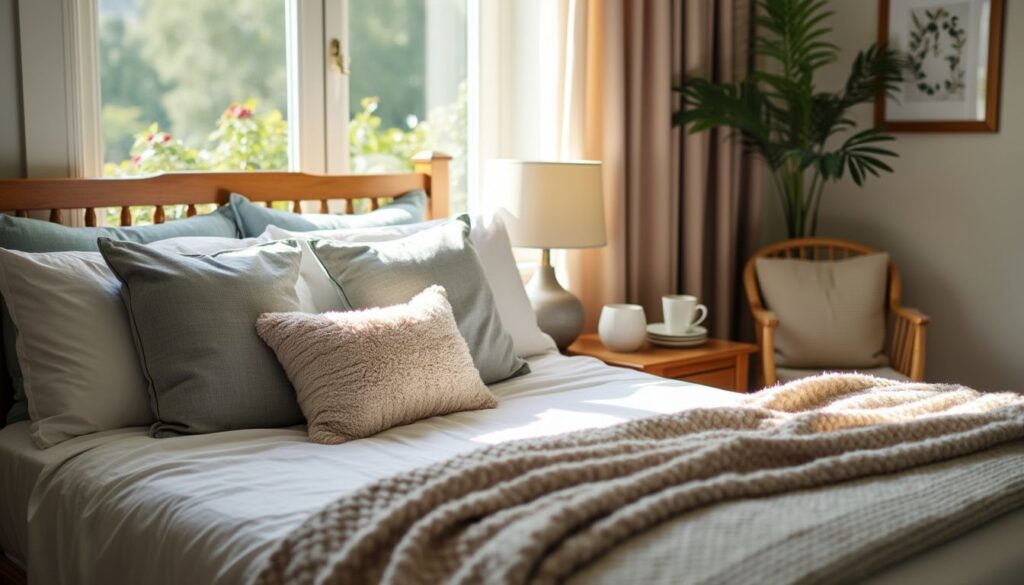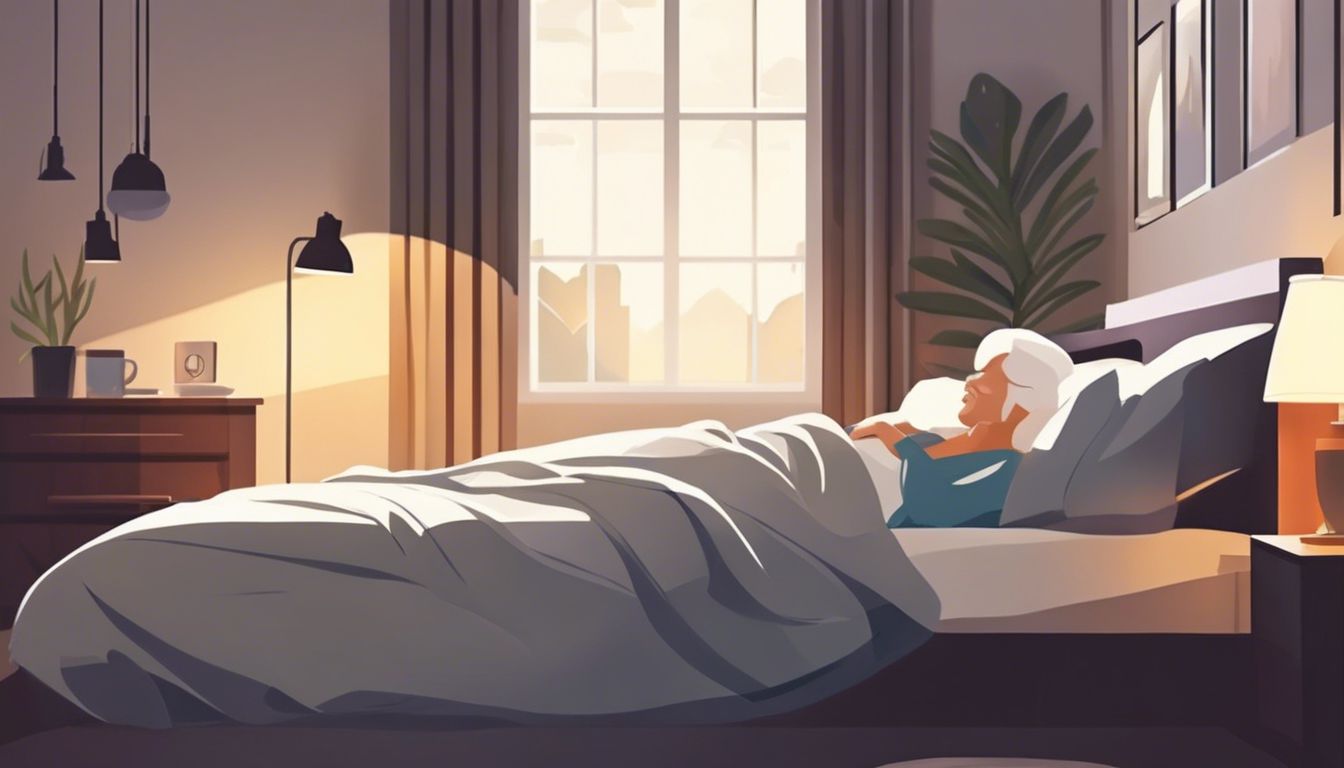Caregivers work hard every day. They need a peaceful bedroom to rest well. This article shows ways to design such a space, with the right bed and lighting. Get ready for simple tips!
Key Takeaways
- Caregivers need beds that adjust and have barriers to prevent falls. Good blankets and pillows add comfort.
- Light levels and noise should be controlled for better rest. Use rugs, paint, and nightlights to help.
- Floors must stop slips, and furniture should not block paths. Keep medical supplies in one spot.
- Smart home devices like lights you talk to make life easier for caregivers.
- Safe, easy-to-move-around spaces help caregivers work well.
Essential Features for a Caregiver’s Bedroom

A caregiver’s bedroom needs a bed that adjusts and supports well. Good lights and quiet are key too for their rest.
Adjustable and supportive bed
A good bed is key for any caregiver’s room. It should let you change its height and angles. This kind lets patients stay safe and stops falls. It also needs barriers on the side. Make sure the bed can be reached from both sides.
This helps when caring for someone.
Choose a homestyle hospital bed if giving long-term care. The room must fit the bed well. For comfort, pick the right blankets to keep warm or cool. Add lots of pillows for support and ease during care tasks in elder care or dementia care settings.
Adequate lighting and minimal noise
After ensuring the bed is right, focus on lighting and noise control. Good light helps caregivers and seniors see well. Install night lights near beds and paths to restrooms. This prevents accidents at night.
For rooms, use paint that makes spaces brighter and reduces shadows.
Noise can stress both caregivers and those in senior care. Use rugs or carpets to lower sounds in bedrooms. Check with patients about light levels and noises often, fixing issues as they come up.
Motion-activated lamps are smart for hallways, making moving around safer at night without touching switches.
Ergonomic and Safe Furniture Arrangement
Choosing the right furniture can make a big difference. Go for pieces that prevent slips and leave plenty of room to move around.
Slip-resistant flooring and spacious layout
Caregivers move a lot at night. They need floors that won’t slip and lots of room. Here’s how to make their bedroom safe and easy to use:
- Choose floors that stop slips. Mats with grip or special tiles help.
- Make sure there’s enough space between furniture. This lets caregivers walk around easily.
- Keep the bed easy to reach from both sides. This helps when they need to help someone fast.
- Use lights that don’t glare but light up paths well. LED nightlights are good.
- Store medical supplies in one spot, out of the way but close by.
- Put a bedside table on each side of the bed for things they need quick.
- Keep doors wide and clear for quick in and out.
These steps make sure caregivers can move safely and fast, helping them do their job better.
Technology for Comfort and Efficiency
Smart lights, voice assistants, and automatic thermostats make life easier for caregivers. They help control the room’s feel with simple commands or a tap on a smartphone. This tech brings comfort and saves time in a caregiver’s busy day.
Explore more to see how these tools can change your space.
Use of smart home devices for ease of access
Smart home devices make life easier for caregivers. They let you control lights, music, and temperature with smartphones or tablets. You can also use voice commands to turn things on or off.
This is good for patients who want to hear music or books without help. Devices like sensor-activated lamps help in the dark. They turn on by themselves when someone walks by. Stove fire prevention gadgets keep the kitchen safe by turning off stoves that are left on.
These tools cut down work and worry for healthcare workers. They give more time to focus on care rather than chores. Next, we look at creating a cozy space with the right furniture setup.
Conclusion
Creating a cozy bedroom for caregivers is all about simple changes that make a big difference. A bed that adjusts, less noise, and just the right amount of light are key. Safe floors and room to move matter too.
Gadgets like smart thermostats or lights you control with your phone add ease and comfort. These steps will help any caregiver feel more at home while they do their important work.
FAQs
1. What are the key elements to consider when creating a comfortable bedroom for a caregiver?
When designing a comfortable room, think about assistive devices like stair lifts, proper illumination and easy access to medicine. The privacy policy of the caregiver should also be respected.
2. How can I finance modifications needed for a caretaker’s comfort?
You might explore options such as personal loans or credit cards to cover these expenses. In some cases, you might receive a lump sum payment that could be used.
3. Is there any financial protection available when making these changes?
Yes! Consumer protection laws may apply in your situation, especially if you’re borrowing money or dealing with contractors for home modifications.
4. Are the costs of modifying my home tax deductible?
In certain situations, yes! Expenses related to caregiving could potentially be tax-deductible under liability deductions but consult with an expert first.
5. Can doctors or behavioral health professionals provide advice on setting up a caregiver-friendly space?
Absolutely! Doctors and other healthcare professionals can offer valuable insights based on their expertise and terms of use in centennial patient care environments.









